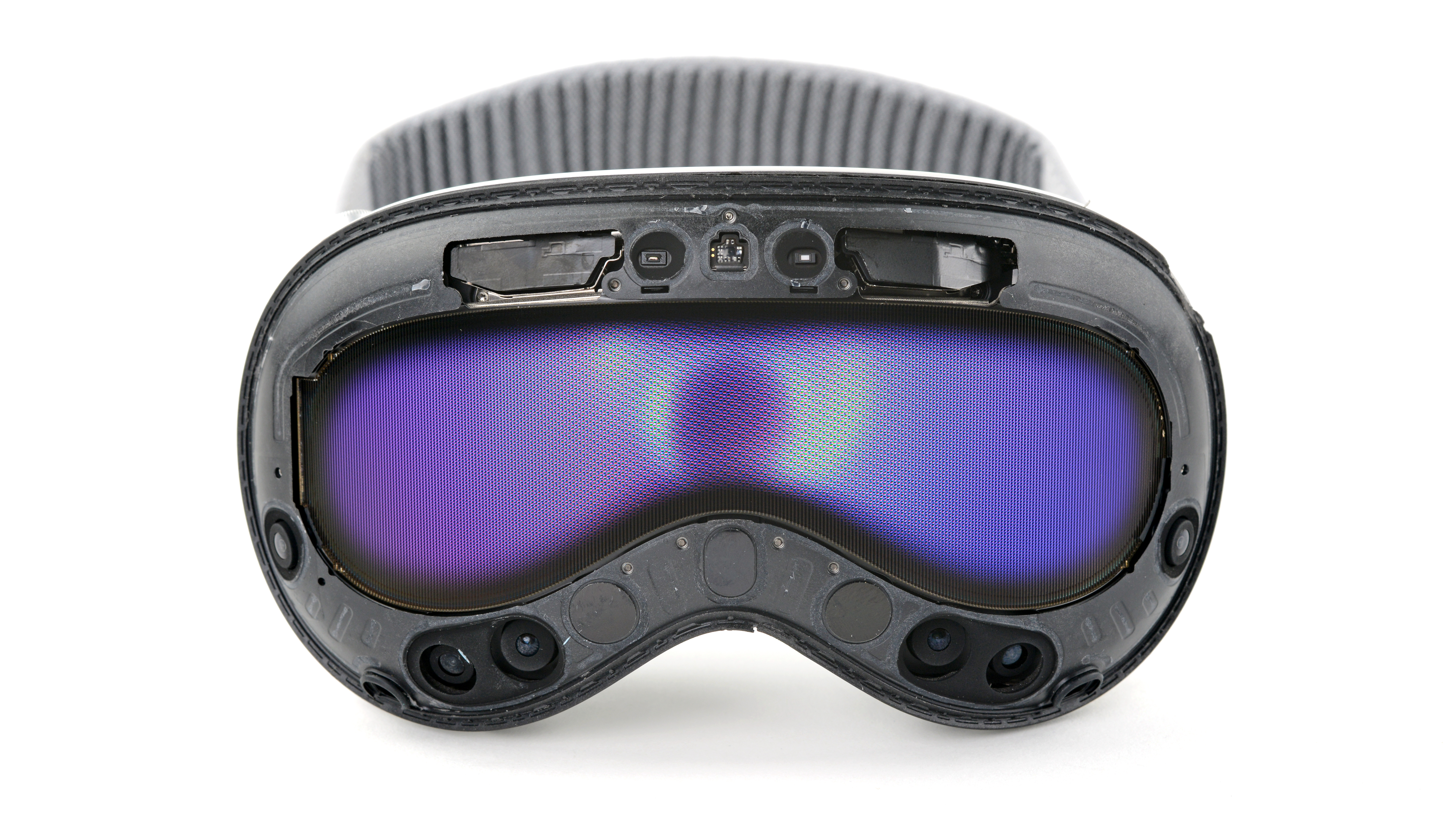- cross-posted to:
- news@lemmy.linuxuserspace.show
- hackernews@lemmy.smeargle.fans

It’s such an Apple thing to put a giant glass panel on the front of a VR headset, which you’re likely to sometimes bump into things when in immersive mode, and then charge $800 for a replacement.

Customers: The glass on our iPhone screens keep cracking.
Apple: Glass on both sides of your phone!

Tbf, Google does it too.

Tbf, both are aggressive customer abusers.

Based on The Verge’s review, you might even accidentally drop it when “holding it wrong”.

So, the electronic parts appear to be 100% non-user-repairable. I’m sure Apple’s main motivation was to reduce the size and weight, but this is still a $3500 disposable item. Has anyone identified the “killer app” yet?

The main motivation isn’t to reduce size and weight. The main motivation is to squeeze the customers for the last ounce of revenue.
The claim that reparability has to be sacrificed for reduction in size and weight is a lie that they reinforced through repetition. They can achieve it without that sacrifice if they wanted to - but it won’t help their perpetual double digit profit growth target.

Im sorry but this is not correct. Most design decisions are a trade-off, you gain something but you loose something. You might argue that reparability should have a higher priority than size, but saying that you can be more repairable without gaining any size is nonsense.

For VR it makes sense as lenses and displays are super fragile and need to be aligned to sub mm precision. But still the battery pack shoudn’t use the proprietary connector for the battery.

Im not sure. you dont want to use anything that might disconnect easily. The battery pack does have an additional USB-C plug to ‘daisy chain’ it to other power source.

That’s completely false. There’s no technical basis for this assertion or tradeoff. On the other hand, there are plenty of device manufacturers that prioritize reparability without sacrificing anything.
The only argument is that Apple and Apple fanbois repeat these claims. But they have vested monetary interests in such a design. That’s why it’s a lie. Agreeing to it just lends credence to Apple abusing their market position. So no.

There absolutely is.
SODIMM slots disappeared from laptops because of technical limitations, and it took an entirely new design to eventually bring socketable RAM back to laptops. And those new sockets still take up more space than just soldering the RAM in place.
Engineering is all about tradeoffs.

Right, but that’s not why companies started soldering batteries. Yes, there’s truth in the concept that with some features you may trade some repairability for some portability, but it’s not like it’s a 1:1. It’s close enough to the truth that it makes a good lie, but if you think Apple’s resistance to allowing users to repair their phones is actually because of decisions made by engineers rather than decisions made in board rooms, I have a bridge in Florida to sell you.

Yes, engineering is all about tradeoffs. But not the ones made by a company with incentives for an unfavorable design. You’re arguing against reparability based on the designs of such a company, not based on what could have been done with reparability in mind.
- intensely_human ( @intensely_human@lemm.ee ) 1•10 months ago
Nope. The set of repairable designs is a subset of the set of constructable designs. Bigger search space means you can optimize the weight further. I wish I could say this in a less abstract sounding way but no, you don’t get to claim that adding a new requirement to a design can definitely be done without sacrificing on weight.
Sure, there’s designs to be had that are in that space, but they’re harder to get to than the design they found.

you don’t get to claim that adding a new requirement to a design can definitely be done without sacrificing on weight
This is the ‘My argument is right because I say so’ argument. You don’t get to unilaterally make unsubstantiated claims like that and then preempt the opposition like that.
Your arguments lack technical merit or the support by real world cases. Have you ever stopped to think that such arguments are only made by Apple and their fanbois? Repeating a lie doesn’t make it true.

I think the key for success will be what the device is able to replace hobby-wise. My favorite part of VR is that it allows me to do this with space restrictions, with some cost offsetting.
For example, there’s a program on Steam called SynthVR. It lets you create a synthesizer rack with as much space as you can imagine. You don’t need a huge room to store all your equipment, you don’t need to spend money on each piece of equipment, you just open VR, load a scene or build it from scratch and you’ve got synths.
From a hobby perspective, I could have spent $1,000 on the Valve Index, or I could have spent it on getting ~5 components for a real synth rack, which I then have to have space in my home for.
That $1,000 for VR however also lets me use Vermillion, a VR oil painting program. I enjoy painting but I’m not the greatest, most of the time it’s tiresome to set up the paint space and put it all away, worry about my huge dog knocking everything over… Or I just have my VR space and paint for a little while.
I also use Paradiddle, a VR drumming program. It can connect to live equipment, or just use it with VR. I don’t have e-drums so I use this for when I’m feeling like using a drum set and not my pads.
IMO, these are what Apple should be aiming for with this device. AR or VR, the best aspects of it always come down to utilizing empty space to give the user a replacement. Even productivity in VR is enjoyable for me because I am huge on VR overlays (like OVR Toolkit or XS Overlay) where you can be in VR and pop open a floating window of a video, or text guide. Rows and columns of documents floating in space, or pinned to your head/hand. I use my phone in VR this way, by connecting my phone to my computer with SCRCPY and then opening it as a panel in VR.
I haven’t kept up with this device too much, and I can’t even say that an AR variant of what I described is worth $3,500, but I could see some promising applications for the device. Not to the extent that people would be walking around with them outside though. At least, not until it’s a few thousands dollars cheaper, and quite a bit smaller.

Has anyone identified the “killer app” yet?
I still don’t see it. I watched a lot of review vids just because it was interesting but I don’t see a single thing that the Vision Pro can do that can’t be done better with other devices.
The tech and computation required for those avatar things is amazing . It might get much better soon. But even if it does, will it be better than simple FaceTime type video conferences?
It’s not clear to me how apple even imagines people using the thing.

VR has been around in modern form for more than a decade and the only truly novel and useful application is some types of gameplay.
Apple claims that the future is AR but the only novel and useful application is feeding you more ads. This is a massive benefit for them, but not a reason for anyone to buy this thing and subject themselves to it.

VR has been around in modern form for more than a decade and the only truly novel and useful application is some types of gameplay.
There are a few other legitimate applications. Architects can offer people a 1st person view of a designed building. There are already companies that let people do VR walkthrough of homes they’re considering buying rather than in person open houses (I think this started in the pandemic).
These things have value but they’re niche applications that can be done with any VR headset.

With this headset’s personalized design, it would probably be uncomfortable for a lot of people to wear one that wasn’t made for them. I’m sure Apple never considered what a shame it would be for each person to have to buy their own…
Either way, other headsets would likely be better for these retail style use cases.

If you watch the original iPhone release video, Steve Jobs talks about combining a phone, iPod, and Internet connected device together into one thing. The crowd cheered at the first two items, but had no real idea why the third item was such a big deal.
I imagine that Apple is experimenting in the space where VR and AR can be mobile. I don’t think they fully understand what a good mobile AR experience should be, but the iPod didn’t launch with an app store.

Except this device is hardly mobile and it’s clearly made to be used stationary.

The device can be used mobile and I’ve seen several reviewers using the device while walking around in a public setting. It looks dumb, but you can do it.
I also think Apple is being conservative in what gets shown while walking because Apple doesn’t want its customers to walk in traffic. However, I expect that to change as Apple gets a better handle on walking distractions.

In their demo video, they show someone working in the kitchen and my visceral reaction was “oh hell no”. I just can’t see any real world, regular use for this thing still. I am happy to be proven wrong though.

The crowd cheered at the first two items, but had no real idea why the third item was such a big deal.
I’m not sure, I took that to mean a competitor to Palm, which was pretty popular among a niche segment of the population. Although data plans via 3G kinda sucked back then and most Palm users I knew were constantly trying to connect to wifi.

More than a “killer app”, it has a “killer feature”: even though it isn’t full AR, it is “Passthrough VR”… with cameras of high enough resolution, that you can use a physical keyboard (VR keyboards stink big time), or your smartphone, without taking it off.
There is nothing more jarring with VR headsets, than having to take it off every time you want to interact with something IRL, even things as simple as taking a sip of water.
disposable item
There will come higher quality, lighter, more efficient versions in the future, but that doesn’t make this one “disposable”, it’s likely to get some support (especially with right to repair legislation) and work well enough for at least the next decade.
PS: INB4 anyone calls me an “Apple fanboy”, I wouldn’t even consider getting one until it gets jailbroken, rooted, and allows dual booting into whatever alternative OS.

You mean other than porn?

It tracks your hands, even at waist level… some say that’s bad, but… it opens quite the amount of “interactive possibilities”, doesn’t it? 😏

it is also true that devices that are packaged as an integrated unit are less likely to experience issues. Reparability is a means toward an end (long lasting products) but not the only one way to achieve it.

The headphones and battery pack are replaceable. I don’t think I’d call this “disposable”

Fair point, but I was just referring to the electronics. Worth all that glue holding it together, whenever iFixIt gives it a repairability score, it’s going to be pretty low.

No headset I’ve seen yet has the capability to effectively replace multiple monitors, which would be the primary use case for working people (likely the biggest market share).

So it has three battery packs each the size of an iphone, yet the battery capacity is only twice that of an iphone? Seems pretty meh, and they lock you in with proprietary connectors.

It uses USB-C for the charging cable. The cable between the headset and power supply is a locking proprietary connector, discussion on hackers news indicates it’s because USB-C locking connectors are not elegant and it has specific power requirements so using it with a random cable and random battery pack is not a good idea. The “battery pack” is also the power supply for the processor, it’s not really locking into a proprietary cable any more than it’s locking you into a proprietary operating system. Saying either of those is essentially meaningless to the discussion of the device.

They didn’t say how thick the batteries are. So saying something like “the size of an iPhone” is really not a good way to measure things. The important information here is that it is a 3-cell pack with ~35Wh.


